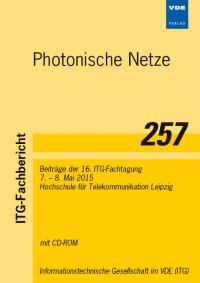Multi-layer interworking with rate-adaptive transmission technology - benefit and challenges of a new use case
Conference: Photonische Netze - 16. ITG-Fachtagung
05/07/2015 - 05/08/2015 at Leipzig, Deutschland
Proceedings: Photonische Netze
Pages: 7Language: englishTyp: PDF
Personal VDE Members are entitled to a 10% discount on this title
Authors:
Gunkel, Matthias; Wissel, Felix; Weiershausen, Werner; Franzke, Martin; Fürst, Volker; Mattheus, Arnold (Deutsche Telekom Technik, Fixed Mobile Engineering, 64295 Darmstadt, Germany.)
Abstract:
Recently, Deutsche Telekom introduced an IP backbone network following the paradigm of multi-layer (ML) resilience (MLR) [1], i.e. a coordinated recovery process in reaction to a failure which comprises packet layer resilience mechanisms, like Fast Reroute (FRR), done by the routers as well as optical switching technology accomplished by reconfigurable optical add/drop multiplexers (ROADM). MLR is expected to improve the service availability and allows to drive overall network cost down. Common to all existing MLR approaches is the utilization of fixed-rate transceiver modules. This paper investigates the potential of future rate-adaptive transmission technology [2] in IP-based backbone and aggregation networks. Hereby, the offered flexibility of so-called flex-rate technology is beneficially utilized in reaction to a network failure*. First, the underlying so-called flex-rate technology is reviewed and the implementation principles of a fine-granular rate adaptation are drafted. Then the expected techno-economic use case in DT’s transport networks based on multi-layer aware operation is outlined under reasonable network conditions. However, in order to translate techno-economics into superior network utilization and real cost advantages, remaining challenges have to be overcome. Therefore, necessary protocol extensions are addressed enabling a seamless. * Besides the typical day-night profile, the authors currently observe no other kind of relevant exploitable dynamics in national metro/aggregation and backbone networks than those that are induced by a sudden network failure.


